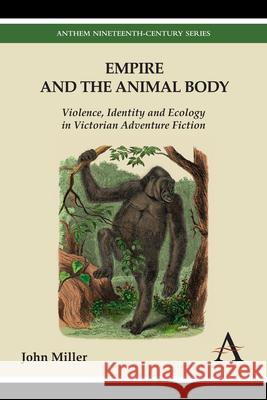Empire and the Animal Body: Violence, Identity and Ecology in Victorian Adventure Fiction » książka
Empire and the Animal Body: Violence, Identity and Ecology in Victorian Adventure Fiction
ISBN-13: 9781783083176 / Angielski / Miękka / 2014 / 244 str.
Empire and the Animal Body: Violence, Identity and Ecology in Victorian Adventure Fiction
ISBN-13: 9781783083176 / Angielski / Miękka / 2014 / 244 str.
(netto: 166,00 VAT: 5%)
Najniższa cena z 30 dni: 163,38 zł
ok. 13-18 dni roboczych.
Darmowa dostawa!
Empire and the Animal Body: Violence, Identity and Ecology in Victorian Adventure Fiction explores representations of exotic animals in Victorian adventure fiction, mainly in works by R. M. Ballantyne, G. A. Henty, G. M. Fenn, Paul du Chaillu, H. Rider Haggard and John Buchan. These primary texts are concerned with Southern and West Africa, India and what is now Indonesia in the period 1860 1910, an era which comprises imperial expansion, consolidation and the beginnings of imperial decline. Representations of exotic animals in such literary works generally revolve around portrayals of violence, either in big-game hunting or in the collection of scientific specimens, and draw on a range of literary sources, most notably romance, natural history writing and penny dreadful fiction. This study investigates how these texts depictions of forms of violence complicate the seemingly fundamental distinction of humans from animals, and undermines the ideological structures of imperial rule. Rather than an innate and hierarchical opposition, the relationship of humans with their animal others emerges in this context as a complex interplay of kinship and difference. This argument both continues the postcolonial dismantling of empire s logic of domination and develops the recentering of the nonhuman in environmentally focused criticism. Most vitally, it also signals the relation between these fields: the necessary interdependence of human and nonhuman interests, environmental activism and global social justice."
Empire and the Animal Body: Violence, Identity and Ecology in Victorian Adventure Fiction develops recent work in animal studies, eco-criticism and postcolonial studies to reassess the significance of exotic animals in Victorian adventure literature. Depictions of violence against animals were integral to the ideology of adventure literature in the late nineteenth and early twentieth centuries. However, the evolutionary hierarchies on which such texts relied were complicated by developing environmental sensitivities and reimaginings of human selfhood in relation to animal others. As these texts hankered after increasingly imperilled areas of wilderness, the border between human and animal appeared tense, ambivalent and problematic.











